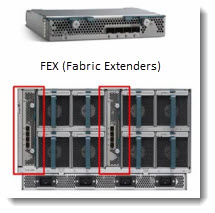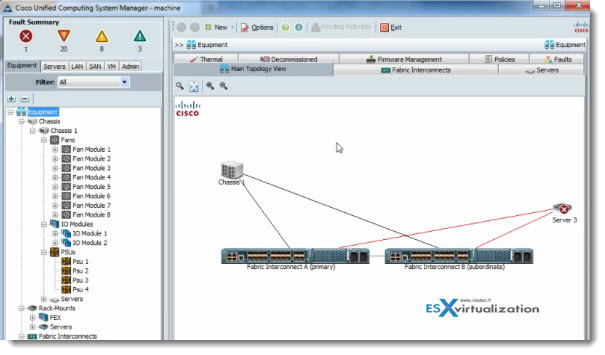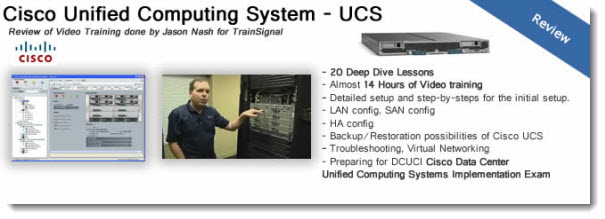The Cisco Unified Computing System (UCS) Training from TrainSignal done by Jason NASH has been here for a while. I had the occasion to learn through this training and as a result I'll try to report on it through this article. I must say, that I did not have a chance to touch Cisco UCS before, so it was a great way of see this technology and learn more about it.
I would need to view and review some parts of this training at least twice. It's packed. Lot's of new terminology.
I have announced this new training which was done by Jason Nash in my detailed post here. Jason Nash had a tough role in this training, since he has managed to squeeze into 20 lessons. The training is almost 14 hours long. In a real class you would spent like 4-5 days to learn this amount of stuff.
If you're not Cisco guy, you might want to re-watch some lessons several times. I did. But, there is nothing wrong with that. I just want to say that, the Cisco and UCS it's… special. Parts of the training you'll see going deep into Cisco switching, through some dirty CLI commands as well, but nothing really nasty.
Just to remind you, Jason Nash is a Cisco Guy, so for him everything is easy….. but he knows his stuff and he shows a lot. Don't forget that he is VCDX…. -:)
What it's needed for this training, is that you can actually reproduce the step-by-step configurations, with the Cisco UCS Platform Emulator. It's a RedHat VM, which run in VMware Player (or Workstation, if you have a license), or you can install it directly on ESXi or vSphere. The emulator is now in version 2.0 and can be downloaded from here : Click here to download. (note: you'll need a Cisco account – you can open one for free). Before installing Cisco UCS Platform Emulator, ensure the system meets the following requirements:
– 1 GB free RAM
– 6 GB disk space
– 1.8-GHz single CPU
– A Mozilla-compatible browser (Firefox or Google Chrome)
– Java Runtime Environment 1.6 that you can download from
Through the first couple of lessons I have learned the config of the lab, that was used for creating this training, and Jason explains the important role of the Emulator, shows how to install, configure, and log into this tool in order to start learning through.
The Cisco UCS platform emulator is used for 90% of the time in this training. Only 10% of this training shows the real blades config. So it means that you can reproduce as much as 90% of this stuff at home without even having access to real Cisco UCS platform. And that's quite cool.
In a real world the emulator software is used by developpers to test new GUI plugins.
I'll detail one lesson from this course, as it's not really possible to detail them all in one single article.
The Cisco UCS-B series lesson
This lesson shows the whole UCS architecture and terminology to help you understand how everything works together. It's important to understand how this all works before the actual installation and configuration starts.
Cisco simplifies the deployment process of Cisco UCS comparing to the classic chassis blade. In fact, Cisco has removed certain components out of the chassis like switches (so there is less IP addresses to manage). So There is no uplinking from each server, from each chassis, (uplinking the strorage network, the management, or the production network). All this is handled by two top-of-rack managment nodes called interconnects.

There is 2 versions of FEXes, the first version is shown on the image on the right. The second gen of FEXes has twice more ports and so you get more throughput.
There is two FEXes in one chassis. There is not IP address to manage on FEX. The management is done through the UCS Fabric Interconnect which is usually installed at the top of the rack, just bellow the network switches.
The Chassis can be filled with half sized blade servers of full size blades, or you can mix both in one chassis. There is 4 power supplies at the bottom. Redundancy matters.
The blade models are also showed. There is 4 models:
There is half size blades B200M2 models. The very popular and standards models, with Dual Socket Xeon 5600 CPU models with 12 DIMMs for up to 192GB of RAM with 16Gigs DIMMs. There are 2 SFF hard disk drives, but if you plan to implement a boot from SAN, it's as an option to boot locally as well.
There are Full size width blades – B250M2 – which are popular for VDI usage. There can be fitted like 140 VDI desktop sessions. Why VDI? It's because the VDI sessions uses quite a RAM but not much computing power. There are 48 DIMM slots for up to 394 GB of RAM with 8Gb DIMMs. There are 2 mezzanine cards for I/O, with two 10Gb ports connectivity in this full width blade, compared to half sized blade which hosts only one mezzanine card.
The Compute Blades – B230M2. Those blades are very popular, since the're half form factor but dual socket Intel E7-2800 CPUs with up to 10 cores each. So you got a half blade with 20 cores ! There si 32 DIMM slots for 512 GB of RAM with 16 GB DIMMs. Two SSDs hard drives, one mezzanine card.
The Compute blades – B440M2 – The biggest one – Quad Socket full width form factor, Intel E7-4800 CPUs (10 cores each = 40 cores !! ). 32 DIMM slots up to 512Gb of RAM with 16GB DIMM modules. There is Four SFF Hard Drives and possible to put 2 mezzanine adapters.
Here is another screenshot from the Training with different types of Cisco's blades servers.
After this lesson finished, I had to take a break, and then watched it again. Too much informations in once. The cisco's terminology, I'm not use to it. This brings some thoughts on the real value of this course, which as great value. Imagine paying like $3500 for 5days Cicso class…..
The course goes on by showing the real installation in the real lab. You'll be able to see all the real hardware components in the lesson called Installing Cisco UCS hardware. You'll see how the hardware is installed and connected physically. The next lesson Exploring UCS Manager detailed options on the UCS Manager, the different menu options and also options to connect to the Interconnects via Putty. You'll be able to connect to the fabric A or fabric B and execute some commands there. Jason shows some deep in commands through putty, there is tons of them !!!
The Full Cisco UCS Training is almost 14 Hours long. But those 20 lessons are very dense. Jason Nash speaks quite fast, so he is able to deliver some great amount of informations through those lessons. If you think that you'll be able to finish this course in one day or two, you are wrong. You'll be wanting to re-watch lessons, that's for sure…..
In the next two, three lessons I learned about the initial configuration of Cisco UCS, LAN connectivity, SAN connectivity. Those are really the basics on the setup this gear. First you'll need to connect yourself to assign the initial IP address for the Interconnects, then you need to connect it to the existing LAN infrastructure and also to the existing SAN infrastructure. Without this, the UCS can't communicate to the outside world. The FC, iSCSI or NFS can be used with UCS, depending of your SAN storage device. You'll go through the FC zoning, lun masking, setting up VSANs and you'll quickly look at Fibre Channel over Ethernet (FCoE ).
All this is really storage specific, and network specific, so if you're planning to be datacenter admin, you'll need to master all this…… unless you plug in some Tintri VM aware Flash Storage gear which is easy to setup. At least for the storage part.
Lessons concerning pools and service profiles are really interesting. In those lessons you'll learn about pre-configuration steps, how-to configure a profile before you install a new blade server. And how profile is applied from a pool, to this server (if the server's hardware match the configuration). You'll learn about different types of pools as well.
Management, backup/restore, permissions for administration…. you'll keep learning through those lessons about the “after installation” process, with the daily management task through the CLI and through the UCS Manager. The full backup is important in order to backup all the configuration of the network settings, storage settings, service profiles.
The full backup is binary backup and the format of config system backup is an XML file. There is also config logical backup, which is a backup of VLANs, VSANs, Service Profiles, Pools, Policies. You can backup service profiles for example to reaply to the DR site or to another UCS system for example.
High Availability lesson – there is pretty much everything redundant in Cisco UCS. There is primary and secondary Interconnect fabric and each one of those has NVRAM which replicates on to each other. In case of power failure the data stays in that NVRAM. Chassis stores data in another NVRAM which is located in the Chassis Management Controler. There is fabric interconnect election process, where there is one leader (primary) and the secondary (subordinary). It's an automatic process, but can be manually forced. There is also a split-brain scenario, which is explained. And what's happening in that situation.
You can prepare for the Cisco DCUCI Exam through this training (one or two lessons at the end of this training) since there are few lessons which you'll be able to prepare yourself.
Wrap UP.
My thoughts on this training. What to say? If you're already Cisco guy and so you know the Cisco networking inside out, you'll love this training when learning new technology. If you're not, then you'll “struggle” a bit, you'll need to watch certain lessons several times, take notes, dig deep on your side as well. But that's the part of the learning fun too, non?
Jason Nash does definitely an excellent job as a teacher, even if I had some time of adaptation for his fast speaking rhythm. But after few lessons I was ok. He explains thinks twice, three times in order for you to get the things right, since the topics are overlapping through lessons anyway. And there is a lot of content there, believe me.
I hope that you enjoyed my review of this Cisco UCS Training.




the course you are reviewing was created in 2011. It’s 2018 now (2017 when you wrote this) Are there any more up-to-date courses?
The post was published in June 2012. You should not pay attention to the “latest update” on the post as even a minor update of any link within the article triggers the date change. But the date isn’t a publish date. Well, you should try PluralSignt as they bought TrainSignal few years back. (There is a trial link at the bottom of the blog).